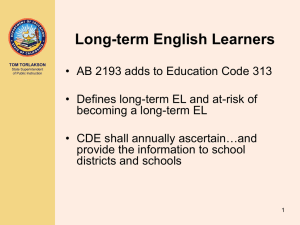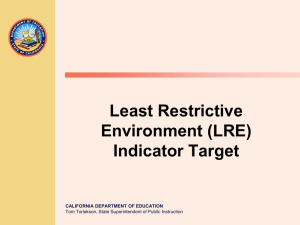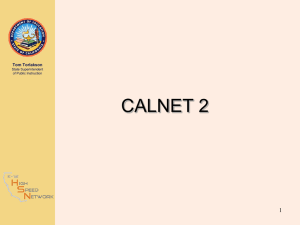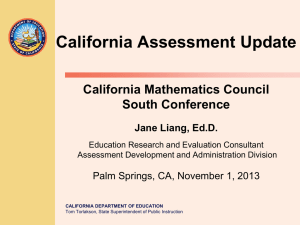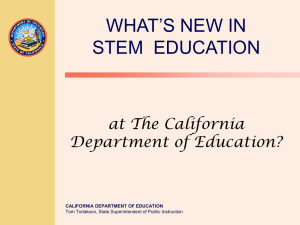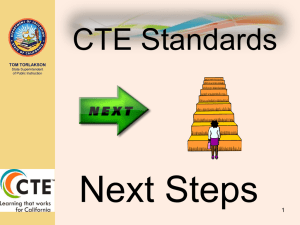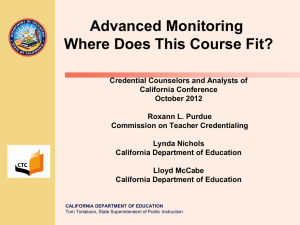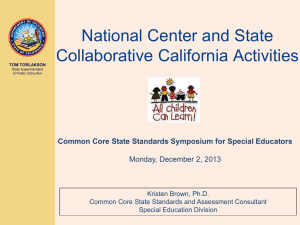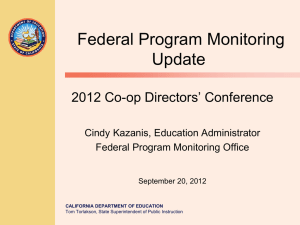ED F C Roundtable and CTE 2014
advertisement
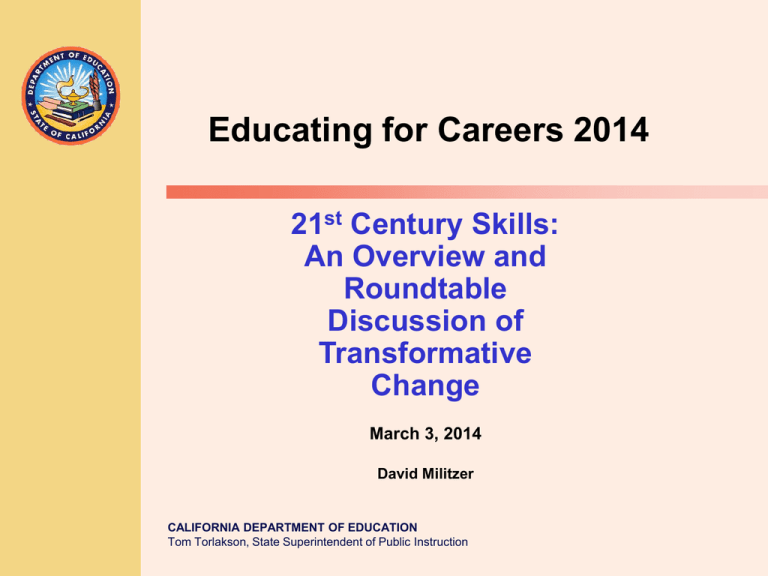
Educating for Careers 2014 21st Century Skills: An Overview and Roundtable Discussion of Transformative Change March 3, 2014 David Militzer CALIFORNIA DEPARTMENT OF EDUCATION Tom Torlakson, State Superintendent of Public Instruction New Policies, New Resources TOM TORLAKSON State Superintendent of Public Instruction Common Core and More: 21st Century Skills and Career Readiness Achieving Moral Purpose TOM TORLAKSON State Superintendent of Public Instruction Why Education? Why Are We Educators? Take a Deep Breath TOM TORLAKSON State Superintendent of Public Instruction “We are operating on the edge of chaos…where rationally constructed reform strategies do not work.” Michael Fullan, Change Forces, The Sequel, 1999, 2000 Since Publication of A Nation At Risk (1983) TOM TORLAKSON State Superintendent of Public Instruction These have been main drivers affecting school reform: • • • • • • • • Higher Standards Higher Expectations (for students, schools, and increasingly teachers) Higher Accountability (with negative motivators) Narrowing of the Curricula Focusing on evaluation of Teachers linked to high stakes Testing Parent Choice – Charter and Home Schooling College Ready for all Budget cuts State Programs Eliminated* Under New Funding System TOM TORLAKSON State Superintendent of Public Instruction Grade 7 – 12 Counseling, Gifted and Talented Education, Civic Education, Economic Impact Aid, High School Class Size Reduction, Principal Training, Professional Development Block Grant, School and Library Block Grant, Professional Development for Math and English, School Safety, Student Councils, Summer School Programs, Teacher Credentialing Block Grant, AVID, et. al. CTE funding (Ag Incentive Grants, Regional Occupational Centers and Programs): funding held harmless for two years (2013 – 2015), then included in Local Control Funding Formula. *Dept. of Finance Student Outcomes TOM TORLAKSON State Superintendent of Public Instruction 100 Students Start 9th grade: • 51 are on a “college prep” track • 75 graduate from high school • 51 enter college • 38 need remediation • 26 graduate college College Completion Toolkit U. S. Department of Education, March 2011 TOM TORLAKSON State Superintendent of Public Instruction Have We Been using the Right “Drivers” for Education Reform ? Effectiveness of CTE TOM TORLAKSON State Superintendent of Public Instruction Research has clearly indicated that CTE is a critical component of a broad and deep school curriculum that addresses career and college readiness. CTE proven models for assisting LEAs in offering programs and curricula consistent with the Common Core, Local Control Funding Formula and Local Control Accountability Plan. It provides relevance and real world content for academic studies while promoting teamwork and cooperative learning. It builds student, teacher, counselor, parent, business, and community engagement. And it encourages students to see a high school diploma and readiness for college or other postsecondary study as a foundation for the future rather than an end in and of itself. It is popular with elected officials, parents, business, and knowledgeable educators. TOM TORLAKSON State Superintendent of Public Instruction No wonder CTE is so widely and enthusiastically supported by students, parents, businesses, and elected officials. TOM TORLAKSON State Superintendent of Public Instruction No wonder CTE is so widely and enthusiastically supported by students, parents, businesses, and elected officials. Using Effective Policies to “Drive” Reform TOM TORLAKSON State Superintendent of Public Instruction Good Drivers vs. Bad Drivers • • • • Capacity Building vs. Accountability Group Work vs. Individual Quality Instruction/Pedagogy vs. Technology Systems Solution vs. Fragmented Strategies Michael Fullan Good Drivers TOM TORLAKSON State Superintendent of Public Instruction • Cause Whole System Improvement • Are Measureable in Practice and Results • Clear Case Can Be Made Michael Fullan TOM TORLAKSON State Superintendent of Public Instruction Life is how you frame it Sign in the window of a boutique frame shop behind CDE What is our framework? What are our “frames”? What are helpful new “frames” and“frameworks” Mission Statement Partnership for 21st Century Skills TOM TORLAKSON State Superintendent of Public Instruction Serve as a catalyst to position 21st Century Skills at the center of U.S. K-12 education by building collaborative partnerships among education, business, community and government leaders. . TOM TORLAKSON State Superintendent of Public Instruction TOM TORLAKSON State Superintendent of Public Instruction Education for Life and Work: Developing Transferable Knowledge and Skills in the 21st Century The National Academies Press, 2012 19th, 20th, and 21st Century Frameworks TOM TORLAKSON State Superintendent of Public Instruction 1. 2. 3. 4. 5. Text book driven vs. Research Driven Passive Learning vs. Active Learning Teacher Centered vs. Student Centered Fragmented Curriculum vs. Integrated curriculum Discipline Problems vs. Students & teachers are co-learners, students are highly motivates 6. Teacher is Judge vs. Self, peer, other assessments 7. Driven by NCLB vs. Driven by exploration, creativity, and 21st century skills. 8. Factory Model vs 21st Century Model Taken from P. Olivia and W. Gordon, Developing the Curriculum, Pearson Publishing, 2013, page 251 Marin County TOM TORLAKSON State Superintendent of Public Instruction • New Playing Field ─ New thinking • Develop Regional Plan with the essential components to meet requirements of LCFF • Applying CTE Standards and Expertise for Common Core Implementation • County-wide efforts to develop “Good Drivers” • Address challenges and opportunities associated with 21st century student outcomes, common core, and deeper learning with Personalized Learning Plans for all students • Use CTE Consortium to piece our Regional Plan together with all stakeholders Orange County TOM TORLAKSON State Superintendent of Public Instruction • • • • • • • Leadership of Orange County Office of Education 21st Century Learning Network The Three Domains and the 5 C’s Interpersonal ─ Communication, Collaboration Intrapersonal ─ Character Cognitive ─ Critical thinking, Creativity Extensive Professional Development and links to P21 Anaheim Union High School District’s 21st Century Skills Resolution, 2011 Savannah High School named “Partnership for 21st Century Skills Exemplar”, July 2013 Student Leadership Campaign for 21st Century Skills Sonoma County TOM TORLAKSON State Superintendent of Public Instruction • Sonoma County’s 4 Priorities: Common Core, 21st Century Learning, CTE, and Data and Assessment • Career and Education Planning For All Students (goal) • Personalized Learning Plans and Tech Support CalCRN – free resources • Focus on building effective collaboration – Cradle to Career; I.E. Sonoma (“Collective Impact”) • CTE, “Maker Movement”, and Middle Grades Transtition Essential Components of K-12 Schools TOM TORLAKSON State Superintendent of Public Instruction • The Instructional/Pedagogical Component (direct facilitation of learning, primarily measured by academic achievement) • The Organizational Component (governance, budgets, management, planning, environment and facilities) • Enabling or Learning Supports Component (building on learner assets, personalized learning, addressing barriers to learning, often aimed at intrapersonal and interpersonal domains) Adopted from UCLA’s Center for Mental Health in Schools Current K-12 Reform Efforts TOM TORLAKSON State Superintendent of Public Instruction • • • • • • Common Core State Standards Local Control Funding Formula Local Control Accountability Plan Smarter Balance Assessments Next Generation Science Standards English Language Development Standards • New API Measures • Career and College Readiness for All • CTE? LCFF/LCAP State Priorities TOM TORLAKSON State Superintendent of Public Instruction A. Conditions of Learning Implementation of standards, course access, county coordination of expelled students, foster youth. B. Pupil Outcomes Achievement: standardized tests, school API, pupils college and career ready, EL Learners who become proficient, EL reclassification rate, % who pass AP exams with 3 or higher, % deemed college ready by Early Assessment Program Other pupil outcomes in subject areas LCFF/LCAP State Priorities TOM TORLAKSON State Superintendent of Public Instruction C. Engagement Parent Involvement: in decision-making, promotion of Pupil Engagement, School Climate: suspension rate, expulsion rate, surveys of pupils, parents and teachers on sense of safety and school connectedness. Pupil Engagement: School attendance rates, chronic absenteeism rates, middle school and high school dropout and graduation rates. and Optional Local Priorities BREAK TOM TORLAKSON State Superintendent of Public Instruction Time Check and Vote Change Process Round Table Discussion Additional Information on Career Development, Resources, Policies and Practice, or ? Change Process TOM TORLAKSON State Superintendent of Public Instruction “We are operating on the edge of chaos…where rationally constructed reform strategies do not work.” Michael Fullan, Change Forces, The Sequel, 1999, 2000 Change Process TOM TORLAKSON State Superintendent of Public Instruction “If you don’t like the future, create a different one!” Change Process TOM TORLAKSON State Superintendent of Public Instruction • What is it? • What can and can’t be anticipated? • Who is involved? • How is it Guided • How is Change Capacity developed? Change Process TOM TORLAKSON State Superintendent of Public Instruction • Chaos theory • Uncertainty about the Future • Evolutionary Forces TOM TORLAKSON State Superintendent of Public Instruction Common Core and More TOM TORLAKSON State Superintendent of Public Instruction • California Career Pathways Program • Career Development • Career Readiness – Defined and Measured • Career Technical Education (CTE) • CTE Program Models Career Readiness Learning Continuum Employment TOM TORLAKSON State Superintendent of Public Instruction Industry Specific licensure and certifications Pathway Knowledge and Skills necessary for success in a CTE pathway Industry Sector Anchor Knowledge and Skills common to a particular Industry Sector Standards for Career Ready Practice What ALL students need to know and understand. 33 Standards for Career Ready Practice TOM TORLAKSON State Superintendent of Public Instruction Increase in complexity and expectation as student advance through a program of study Are taught and reinforced in all career exploration or career preparation programs, or integrated into core curriculum For ALL students, not just CTE students 34 Standards for Career Ready Practice TOM TORLAKSON State Superintendent of Public Instruction Adapted from the National Career Technical Common Core Align with Skills for the 21st Century Describe the fundamental knowledge and skills needed to be ready for careers AND college Adapted from the National Common Career Technical Core Not exclusive to a career pathway, CTE program of study, a particular discipline, or grade level 35 Standards for Career Ready Practice TOM TORLAKSON State Superintendent of Public Instruction 1. 2. 3. 4. 5. 6. 36 Apply appropriate technical skills and academic knowledge Communicate clearly, effectively, and with reason Develop an education and career plan aligned to personal goals Apply technology to enhance productivity Utilize critical thinking to make sense of problems and persevere in solving them Practice personal health and understand financial literacy Standards for Career Ready Practice (continued) TOM TORLAKSON State Superintendent of Public Instruction 37 7. Act as a responsible citizen in the workplace and the community 8. Model integrity, ethical leadership, and effective management 9. Work productively in teams while using cultural/global competence 10. Demonstrate creativity and innovation 11. Employ valid and reliable research strategies 12. Understand the environmental, social, and economic impacts of decisions CTE Standards for Career Ready Practice TOM TORLAKSON State Superintendent of Public Instruction Adapted from the National Career Technical Common Core Align with Skills for the 21st Century Describe the fundamental knowledge and skills needed to be ready for careers AND college Adapted from the National Common Career Technical Core Not exclusive to a career pathway, CTE program of study, a particular discipline, or grade level http://www.cde.ca.gov/ci/ct/sf/ctemcstandards.asp 38 Standards for Career Ready Practice Example TOM TORLAKSON State Superintendent of Public Instruction 3. Develop an education and career plan aligned to personal goals. Career-ready individuals take personal ownership of their own educational and career goals and manage their individual plan to attain these goals. They recognize the value of each step in the educational and experiential process, and that nearly all career paths require ongoing education and experience to adapt to practices, procedures, and expectations of an ever changing work environment. They seek counselors, mentors, and other experts to assist in the planning and execution of education and career plans. 39 Personalized Learning and Individual Learning Plans/Student Learning Plans TOM TORLAKSON State Superintendent of Public Instruction When Implemented Well……. – Addresses Career, Postsecondary, and Life Goals – Informed by Career and Self Exploration prior to High School – Motivates all students to “own their own learning” – Can increase engagement of students, teachers, support personnel, parents, and community when implemented well – Positive impact on school climate – Improve academic performance, attendance, graduation rates – Optional modes of delivery: extra-curricular, classbased, “advisory”/school counselor California Career Pathways Program TOM TORLAKSON State Superintendent of Public Instruction • Funding Period: July 2014 – June 2018 • Funding Available: $250 million • Can be used for CTE Pathways and Address Career Readiness for All California Career Pathways Program TOM TORLAKSON State Superintendent of Public Instruction Grants shall be available for K-14 career pathways programs that address any or all of the following goals: 1. Fund specialists to…establish or enhance locally defined career pathway programs connecting education and business. 2. Establish regional collaboratives…and partnerships with business entities, community organizations, and postsecondary education. 3. Develop and integrate standards-based academics with career curriculum following industry-based pathways aligned with growing economic sectors. California Career Pathways Program TOM TORLAKSON State Superintendent of Public Instruction 4. Provide articulated pathways to postsecondary education aligned with regional economies. 5. Leverage or build on any of the following: – – – – Perkins, CPAs, ROCPs, etc. Matching resources The California Community Colleges Economic and Workforce Development Program and its sector strategies and deputy sector navigators Participation in the local California community Colleges Skills Panel. ******* TOM TORLAKSON State Superintendent of Public Instruction California Career Resource Network (CalCRN) TOM TORLAKSON State Superintendent of Public Instruction Mostly free resources available from the CDE through the CalCRN homepage at www.californiacareers.info , including: The California Career Center with career and college planning resources The California Career Zone, a web-based career exploration system The California Career Planning Guide, a hard copy resource for student development of a personal career action plan Find and Get the Right Job student guide, covers the basic steps in finding work Succeed at Work student guide, helps transition to working and retaining employment Career Surfer, mobile application available through iTunes and Google Play Career Readiness Delivery Models: The “How” TOM TORLAKSON State Superintendent of Public Instruction • • • • • • • • • California Partnership Academies Career Academies Career Pathways Linked Learning Pathways Magnet Schools NAF Academy Regional Occupational Centers/Programs Smaller Learning Communities STEM or STEAM Academies TOM TORLAKSON State Superintendent of Public Instruction David Militzer Education Programs Consultant Partnership for 21st Century Skills High School Innovations and Initiatives Office Career and College Transitions Division Instruction and Learning Support Branch California Department of Education 916 323-5146 E-mail: dmilitzer@cde.ca.gov
